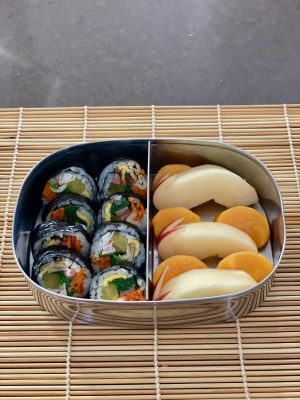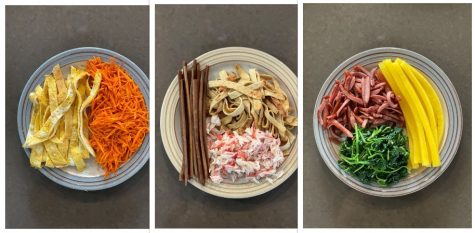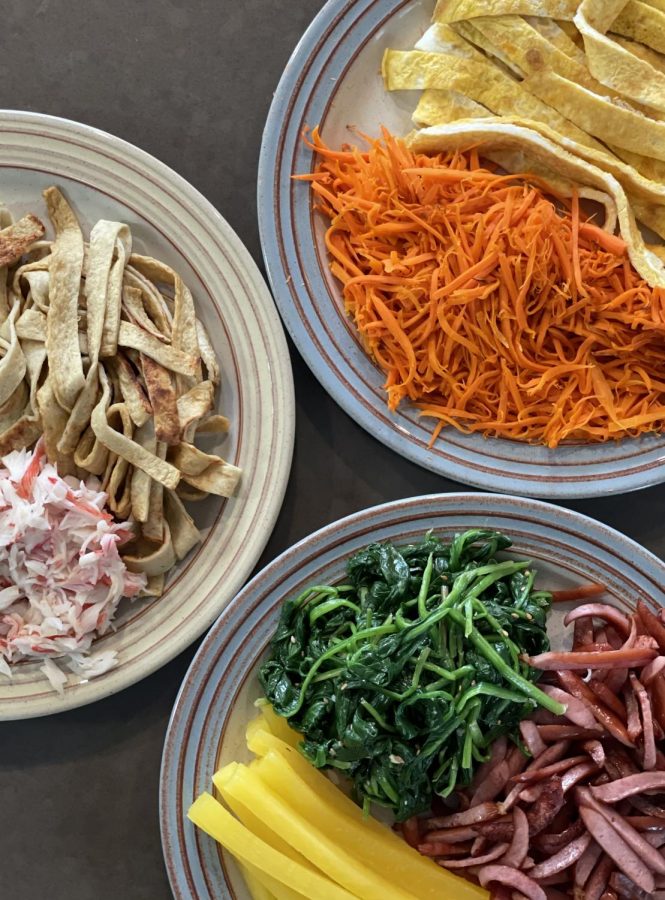Opinion: How to: A Korean Gimbap

At the beginning of quarantine, when I was cleaning out my cluttered stack of green and pink notebooks, I found a small resolution that I had written in fourth grade. “Learn Grandma’s Gimbap recipe.”
I smiled and was reminded of how I wanted to keep the octopus leg bowls and kimchi fried rice of my Korean culture away from my school friends in first grade. I was embarrassed by the lunch boxes my mother carefully packed, especially when my friends at school poked at my food and asked what it was. But every time I asked my mom for a normal ham sandwich like everyone else, she refused to pack me one, saying, “This food is what makes us Korean. If you can’t eat like a Korean, what are you?”
In the fourth grade when I enrolled at Westridge, I met many people from all different cultures. My classmates brought everything from kale and quinoa salads to pork-belly dumplings and fish tacos. I realized I didn’t need to act more “American.” I also realized then that I didn’t know anything about the Korean food my family had been preparing because ham sandwiches and hot dogs were all I wanted and thought about. That was when I made the resolution to learn my grandmother’s Gimbap recipe, something we made every week when I visited Korea. As I saw the short note in the notebook, I decided to use the extra time in quarantine to reconnect with my culture.
Gimbap was created in the 1980s in school picnics for mothers to show their cooking skills but grew to be the most popular specialty comfort food. Often, many students have it as their lunch when they are cramming for tests as a relief food, but it has become popular all over the world for its healthy ingredients and colorful display. Gimbap has changed my view on the importance of my Korean heritage, and I hope that everyone can enjoy this simple, traditional Korean dish.
KOREAN GIMBAP
Total time: 20 minutes preparation, 10 minutes per roll
Servings: 5 rolls, 2–3 people
Ingredients:
Inside the Gimbap:
- 5 carrots (cut into matchsticks)
- 8 to 10 ounces regular package spinach (cooked and squeezed dry)
- 3 eggs (will be beaten and cut into strips)
- 4 strips imitation crab sticks (pre-cut into strips and then shredded)
- 6 sausages (cut into small pieces)
- 5 strips yellow radish pickle (rinsed in cold water and strained)
- OPTIONAL: bulgogi, spam, or braised burdock root
Outside the Gimbap:
- 4 cups cooked white rice, medium grain (not too sticky)
- 1 tbsp sesame oil
- 5 dried seaweed sheets
- Gimbap rolling bamboo mat to roll the Gimbap together (is sold in stores)
In the lunchbox:
- 2 persimmons (cut)
- 2 apples (cut)

Directions:
- To prepare everything going into the gimbap roll, stir-fry all of the ingredients in a pan except for the yellow radish pickle, spinach, and egg. For the egg, you should beat 3 many eggs together, cook them in a pan into a thin omelet, and cut into ½ inch strips.
- To get the rice ready, you should put warm white rice in a bowl, straight out of the rice cooker, and add a tablespoon of sesame oil to it. Mix them together until they are well-thoroughly integrated and the rice is not sticky. If the rice is sticky, you can add more sesame oil.
- To assemble, put a dried seaweed sheet on the Gimbap rolling bamboo mat.
- Next, add a thin layer of rice, smoothing the rice out with your hands so the rice isn’t too thick. The rice layer should be very thin.
- Then add all the ingredients together in a line about ⅓ from your end of the mat. They should be lined on top of each other.
- After that, roll the dried seaweed sheet over the stacked ingredients, and tighten the roll as firmly as possible.
- Next, take the roll and cook it in a pan, slowly turning every couple of minutes. You should cook it at low temperature for 3~5 minutes, then take it out and wait two minutes. Finally, to cut it into ½ inch pieces.
- Optionally, for the finishing touch, cut some persimmons and apples to eat along with your Gimbap.

Lauren Cho is a junior Spyglass Design artist. She has spent the last two years as a staff writer, but she wanted to join the Design Team this year to...

















![Dr. Zanita Kelly, Director of Lower and Middle School, pictured above, and the rest of Westridge Administration were instrumental to providing Westridge faculty and staff the support they needed after the Eaton fire. "[Teachers] are part of the community," said Dr. Kelly. "Just like our families and students."](https://westridgespyglass.org/wp-content/uploads/2025/03/dr.-kellyyy-1-e1748143600809.png)














































